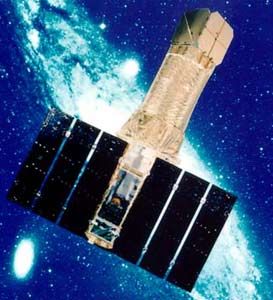
Home - Search - Browse - Alphabetic Index: 0- 1- 2- 3- 4- 5- 6- 7- 8- 9
A- B- C- D- E- F- G- H- I- J- K- L- M- N- O- P- Q- R- S- T- U- V- W- X- Y- Z
ASCA
 Asuka Credit: Manufacturer Image |
Status: Study 2005. Height: 4.00 m (13.10 ft).
It was Japan's fourth cosmic X-ray mission, targeting the x-ray background, active galactic nuclei, galactic clusters, supernovae, and their remnants.
Part of the scientific payload was provided by the United States. After 8 months of instrument validation, ASCA, early known as Astro-D, became a guest observer project, with astronomers from Japan, the US, and members states of the European Space Agency having access to the program. This was the first satellite to use CCDs for X-ray astronomy.
The spacecraft's solar arrays provided 601 W BOL / 489 W after 3 years and recharged two 19 Ahr NiCd batteries. Three-axis attitude control by four reaction wheels. Data from a bubble memory recorder (134 Mb) was downlinked on X-band at 264 kbit/sec. The tubular telescoping optical truss was constructed of carbon fiber which was folded for launch, and was extended by a sliding mechanism after reaching orbit.
The payload consisted of four x-ray telescopes, consisting of four sets of coaxially aligned multilayer thin foil mirrors provided by GSFC. At the focus of two of the telescopes was a Gas Imaging Spectrophotometer (GIS) consisting of two gas imaging scintillation proportional counters covering 0.7-10 keV. The second focal plane instrument was a solid-state imaging spectrometer with two CCDs covering 0.5-8 keV. Electric System: 0.389 average kW.
NASA NSSDC Master Catalog Description
The objective of this mission was to perform spectroscopic X-Ray astronomy in the wavelength band 1--12 KeV, with particular emphasis on spectroscopy of the iron K band. Another objective of ASCA was imaging of the structure of extended sources such as clusters of galaxies and supernova remnants. ASCA carried four identical telescopes with a total effective area of 1300 cm**2 at 1 KeV and 600 cm**2 at 6--7 KeV. ASCA was a cooperative mission between Japan (ISAS) and NASA. NASA provided four conical grazing incidence, multilayer thin foil mirrors. Two CCD-based detectors were provided by MIT. Japan provided the imaging gas scintillation proportional counters (IGSPC), the spacecraft, the launch vehicle, and a ground station. In return for its scientific instrument contribution, NASA was allocated 15% of the observing time after the initial seven or eight month Performance Verification (PV) period. In addition, 25% of the observing time was set aside for collaborative proposals between US and Japanese scientists.
The satellite was launched on February 20, 1993. A solar flare on 14 July 2000 caused heating and expansion of the upper atmosphere, which increased the drag and external torque on ASCA. The attitude was perturbed, so the solar panels lost lock on the Sun, resulting in discharge of the batteries. ASCA reentered the atmosphere on March 2, 2001.
Family: Astronomy, X-ray astronomy satellite. Country: Japan. Agency: ISAS. Bibliography: 2, 279, 6.
Back to top of page
Home - Search - Browse - Alphabetic Index: 0- 1- 2- 3- 4- 5- 6- 7- 8- 9
A- B- C- D- E- F- G- H- I- J- K- L- M- N- O- P- Q- R- S- T- U- V- W- X- Y- Z
© 1997-2019 Mark Wade - Contact
© / Conditions for Use